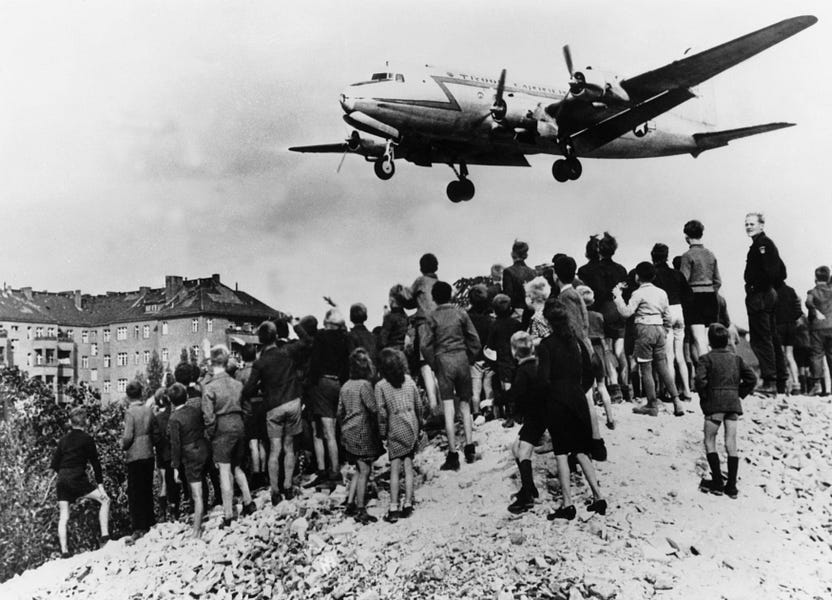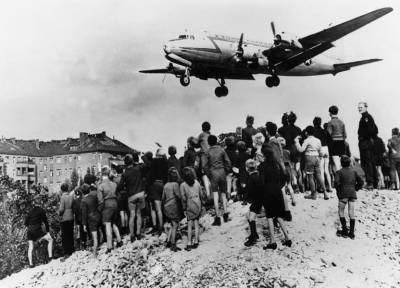When President Joe Biden compared the U.S. evacuation of Afghanistan to one of the most important moments in the Cold War, the 1948-49 Berlin Airlift, heads swiveled in surprise—many in indignation. And no wonder. The Berlin Airlift was a triumph of American power in the face of evil. While the airlift from Kabul was technically impressive—more than 100,000 people in less than two weeks—no one except Biden could possibly see the chaos that unfolded during those two weeks as anything less than a national defeat.
Nonetheless, the story of the Berlin Airlift shows that the use of American air power to save the lives and freedom of 2.5 million Berliners was never inevitable; in fact, the result was often in doubt. It also shows that the character of a president and his advisers, especially his military commanders, can turn an apparent defeat into unexpected victory—or do the opposite.
In the early morning of June 24, 1948, Russian troops stopped every train, truck, and barge carrying food, coal, and other supplies to the western sector of Berlin. About 2.5 million people faced starvation—that was, unless the other Allied powers, Britain, France, and the United States, did something to stop it.
There were three options. The first was to pull out of Berlin and abandon the war-devastated city to total Soviet control. The second was for the western Allies to stand firm in their occupation sectors of the city, and hope the population of the biggest city in Europe could somehow survive without food or fuel.
Or the Allies could resolve to deliver supplies in defiance of the blockade—by force if necessary. While the military governor of the U.S. occupied zone, Gen. Lucius Clay, believed the Soviets wouldn’t resist if an armed convoy tried to push through the blockade, Washington and London worried this might trigger World War III—a war the U.S., despite owning atomic bombs, was in no position to fight. The Red Army had 20 divisions in the neighborhood. The Americans, British, and French had exactly three.
Washington and authorities on the ground had to look at another option: flying supplies into Berlin over the Soviet blockade by air. It is important to realize the fabled Berlin Airlift was a last-resort throw of the dice, when no other option seemed possible. Instead of the futile gesture many predicted, including some in the Air Force, it became a display of American power—and American compassion—that saved a city, turned around the Cold War, and probably saved President Truman from electoral defeat that November.
In fact, the process of flying supply planes into Berlin began even before any official policy was agreed upon. The very first flights were the inspiration of a key member of the planning board for the Normandy invasion, Gen. Albert Wedemeyer, who urged Gen. Clay to load available transport planes to support the stockpiles of coal Berliners needed for fuel—stockpiles slated to last less than a month. Clay called Air Force Gen. Curtis Lemay, the mastermind of the strategic bombing campaign that defeated Japan and who was now in charge of air forces in Europe. Clay asked him point-blank: Can you deliver coal into Berlin?
“The Air Force,” Lemay answered, “can deliver anything.” But even LeMay knew that his planes could meet only 1 percent of Berlin’s needs. The transport plane on hand was the C-47 Dakota, which could carry 6,000 pounds per flight, and Lemay had only 70 that were able to fly. He and Berlin needed the much bigger C-54 Skymaster, capable of carrying 20,000 pounds. There were only two in Europe.
That first day of airlift saw 32 flights in and out of Berlin’s main airport at Tempelhof, carrying 160,000 pounds of fresh milk, bags of flour, and vaccines. RAF planes toted another 70,000. Eight million pounds a day, however, were needed to keep Berlin from starving. Lemay himself flew several of these early flights, but it soon became clear that even with additional transport planes, they were fighting a losing battle—even as the Soviet cordon tightened and pressure grew to force Berliners to abandon any hope of a free and fair election for a new mayor of Berlin, since the Russians knew the winner would certainly be an anti-Communist Social Democrat.
The conditions for supplying couldn’t have been worse. Tempelhof airport had a dangerously short runway, and a large apartment building close to the runway proved a constant navigation hazard, especially in bad weather, which was more the rule than the exception. The supply chain was haphazard to say the least: One flight brought 5,000 pounds of mimeograph sheets; another French wines. Even doubling 2 million pounds of supplies per day the Americans and British were managing with maximum effort, the effort still fell well short of the minimum 8 million pounds needed.
In August, however, this heroic but ad-hoc program was overhauled by Gen. William Tunner, who had run the American supply flights from India to China during World War II. Tunner understood it wasn’t the size or number of planes that mattered, but how fast they could unload their cargoes and head back for more. His basic attitude was, “the trouble with all airplanes is that they spend too much time on the ground.”
Tunner systematized the flight schedule so that turnaround time shrank from an hour to 15 minutes. Under Tunner—nicknamed “Willie the Whip”—a plane either took off or landed at Tempelhof every 90 seconds, with planes spaced three minutes apart in the air. Soon Tempelhof became the busiest airport in the world, as the amount of supplies steadily rose to 10 million pounds per day of food and fuel.
Taken together, the U.S. Air Force and the Royal Air Force pulled off nearly 300,000 flights into Berlin over 11 months, from June 24, 1948, to May 11, 1949, bringing 2.3 million tons of food, coal, and other supplies: a material stockpile equaling one half of the Great Pyramid.
Two people besides Tunner made it happen. One was President Harry Truman. Despite the seemingly hopeless mission and relentless pressure from Air Force and other “experts” insisting the airlift couldn’t be sustained—and also caught in a presidential campaign seemed doomed to defeat—Truman stuck with the airlift’s humanitarian mission and its larger goal: preventing the Soviets from scoring a major moral and strategic victory if the Allies abandoned Berlin. Truman ended a key meeting in July 1948 by telling his staff, “We’re not leaving Berlin,” and he never wavered.
The second hero of the airlift was Lucius Clay. Clay never gave up on his original theory that an armed convoy would get through. But he also understood the airlift had become symbolic of American power and proof there would be no retreat in the face of Soviet pressure or intimidation. Even when the Soviets announced they would be flying military exercises in the middle of the three 20-mile-wide air corridors to Tempelhof, the flights went on.
The other heroes were the hundreds of pilots—British, Canadian, and Australian among them, but mostly American—who flew these hazardous missions day after day. Most were World War II veterans, many of whom had been dropping tons of bombs on Berlin only three years earlier, but who were now risking their lives to keep the city alive. The one who especially caught media’s attention was Air Force veteran Hal Halverson and his “candy bombs,” i.e., offerings of Hershey bars and other treats dropped by handkerchiefs to the hundreds of German children who gathered to watch the spectacle at Tempelhof. Even one of the worst winters of the decade, when five days of intense fog nearly halted all flights and pushed the city to the brink of starvation, couldn’t stop the airlift pilots from carrying out their around-the-clock mission.
Yet that terrible winter of 1948-49, when the average Berliner’s daily protein ration was a quarter stick of margarine and a two-ounce slice of Spam, marked the turning point. When spring arrived, the supplies rose to staggering numbers. At the end of February, Tunner’s planes were moving 16 million pounds to Berlin per day—twice the minimum amount—and for the first time were supplying fresh meat. Some flights even carried Limburger cheese, although pilots eventually rebelled and refused to carry any more. For Passover in March, the airlift brought over 10 tons of matzah and 3,000 liters of Passover wine for the 4,600 Jews still living in post-Holocaust Berlin.
By now the Soviets were looking for a way out. Despite intimidation and voter fraud, including stealing ballot boxes, the mayoral election took place and Social Democrat Ernest Reuter, a keen supporter of the U.S. effort, got more votes than all the other candidates combined. Meanwhile, the stockpiles of supplies the Russians had built up in Berlin’s eastern zone in order to tempt Berliners to give up and accept Soviet occupation, rotted untouched in its warehouses.
On May 4, 1949, the blockade was finally lifted. The Soviets had suffered a moral and political defeat, as Berlin, the former Nazi capital, was now firmly in the pro-Allied camp—at least its western sectors. The boundary between the Soviet Zone and allied sectors became the central axis of the Cold War in Europe, and the checkpoints separating the two halves of the city came to represent passing from one world—even one reality—to another.
It’s also likely that Truman’s courageous stand in support of the airlift gave him victory in the 1948 presidential election. Voters recognized that Truman had used all available American power to stand up to tyranny, in order to protect the innocent.
Here perhaps is the sharpest contrast with President Biden, who arguably used that power to give in to tyranny and abandon the innocent to an unearned fate.
The State Department has acknowledged that “the majority” of the 18,000 Afghan Special Immigrant Visa (SIV) applicants have been left behind, and estimates suggest that the overall number of U.S. visa-eligible Afghans is much higher. These figures mark the biggest mass betrayal of a wartime ally in American history.
All the same, the Kabul evacuation does prove one thing. The U.S. military can still do whatever is asked of it, and accomplish whatever mission is set in front of it. It’s the nature of what’s asked, and what kind of strategy dictates the mission, that determines whether it succeeds or fails—and ultimately whether the United States remains a powerful and respected nation, or not.
Arthur Herman is senior fellow at the Hudson Institute. He is author of Freedom’s Forge: How American Business Produced Victory in World War II and most recently, The Viking Heart: How Scandinavians Conquered the World.





Please note that we at The Dispatch hold ourselves, our work, and our commenters to a higher standard than other places on the internet. We welcome comments that foster genuine debate or discussion—including comments critical of us or our work—but responses that include ad hominem attacks on fellow Dispatch members or are intended to stoke fear and anger may be moderated.
With your membership, you only have the ability to comment on The Morning Dispatch articles. Consider upgrading to join the conversation everywhere.